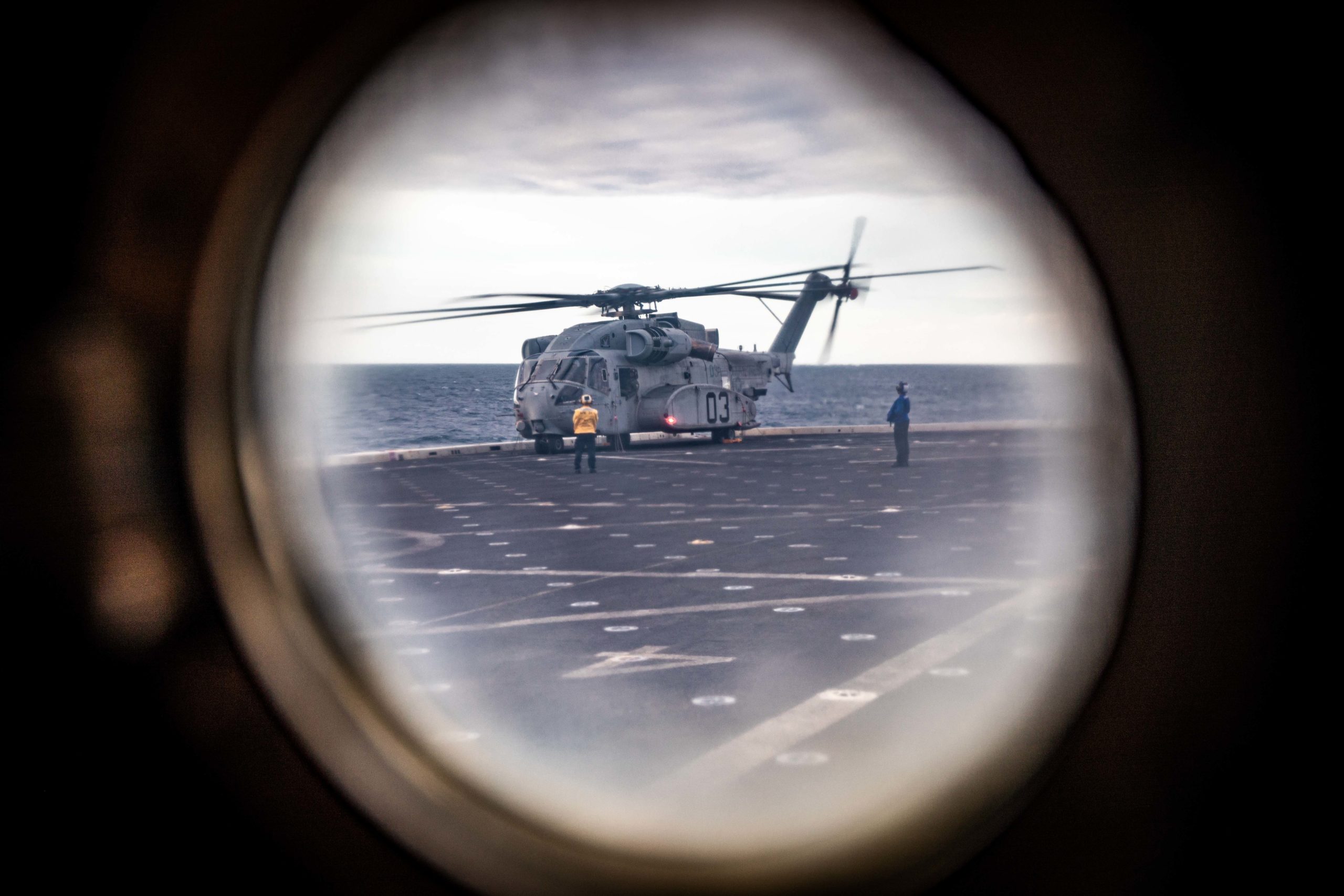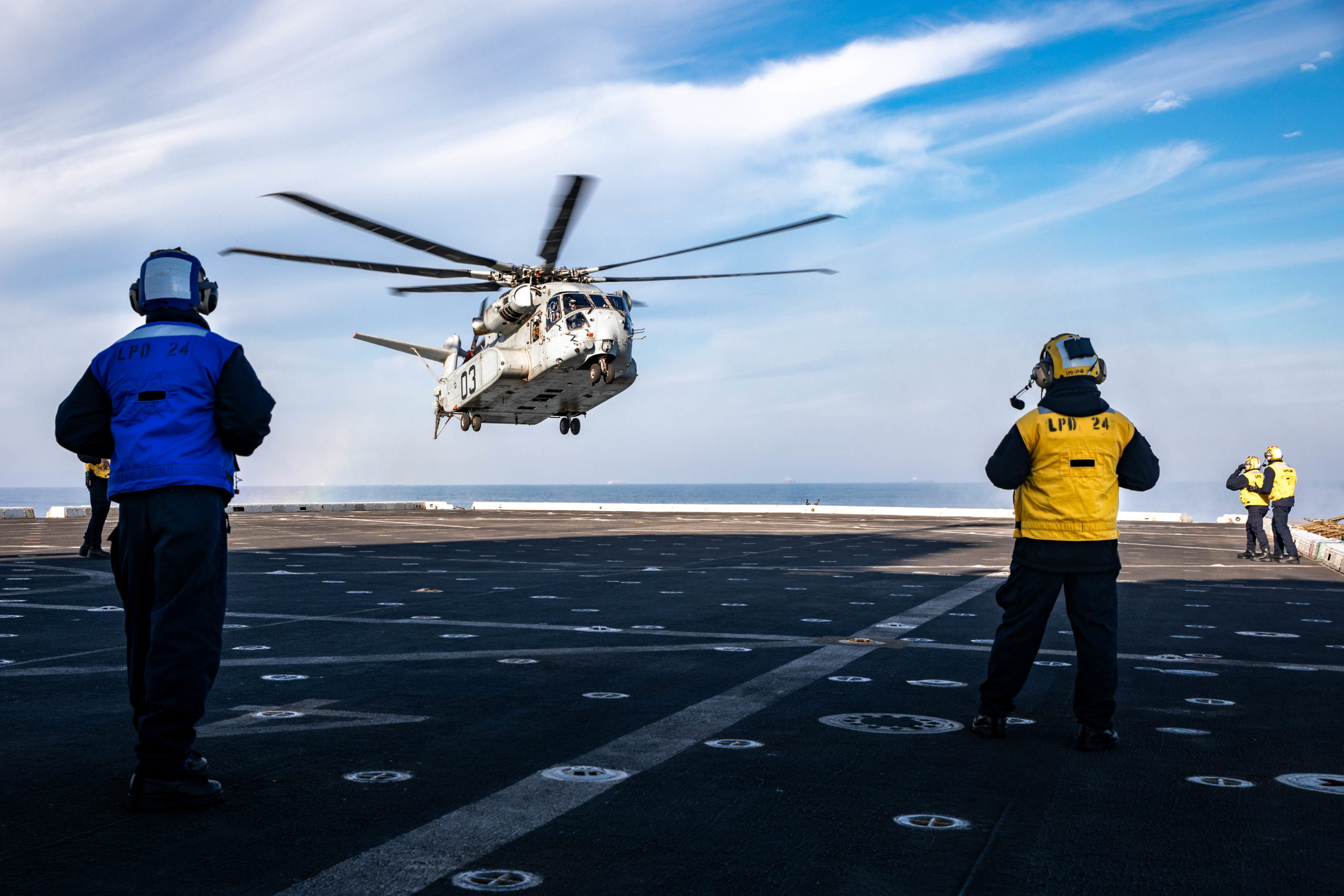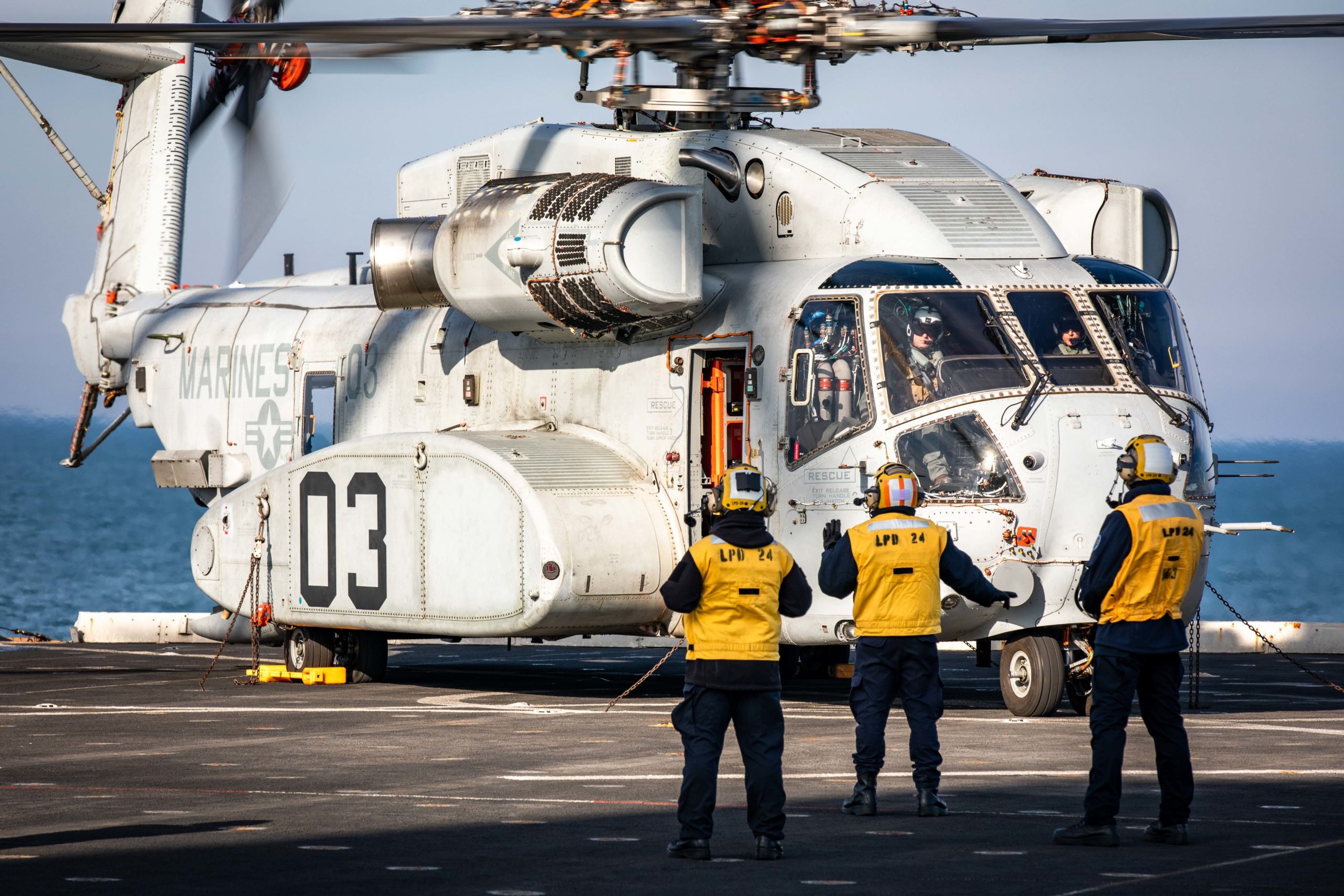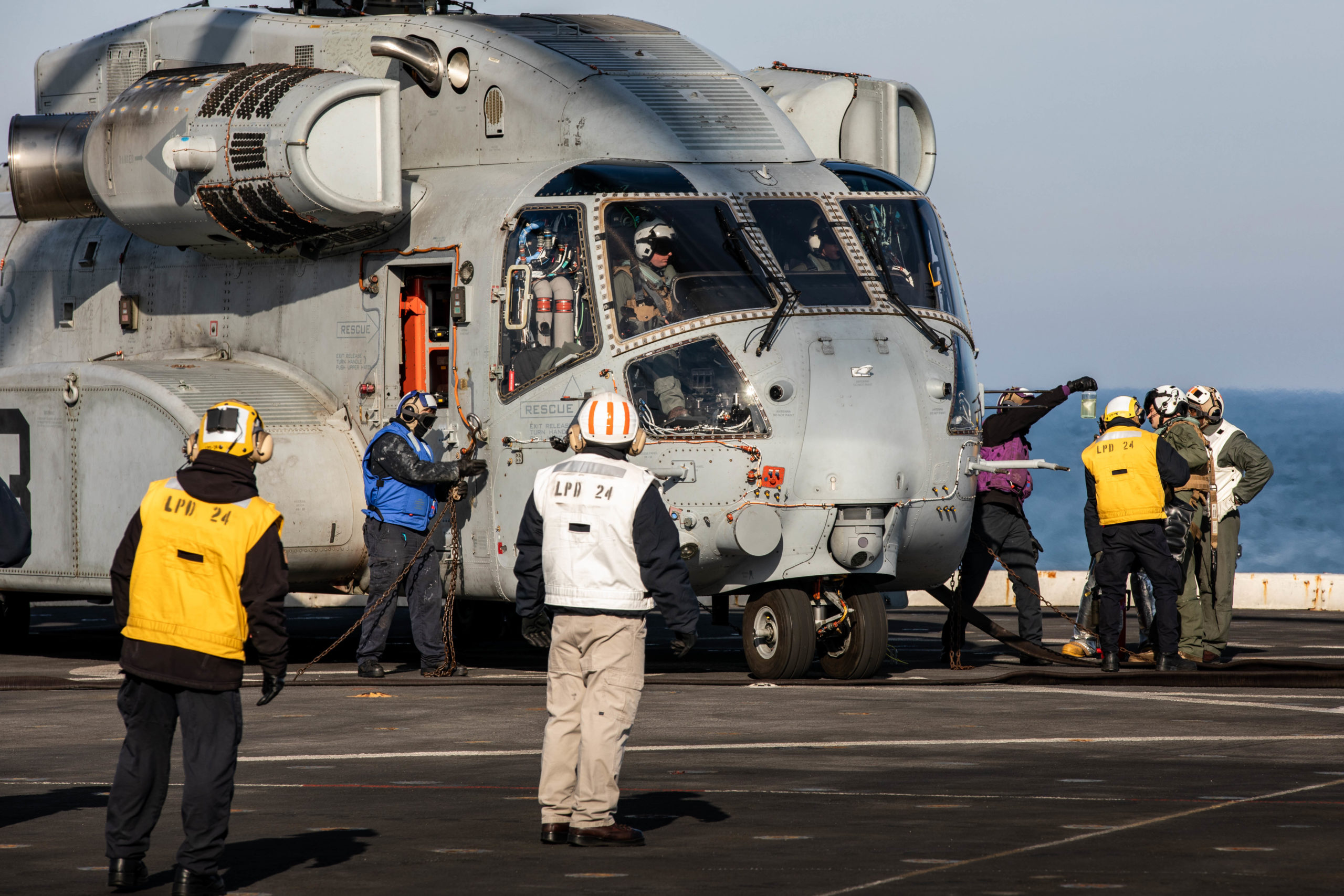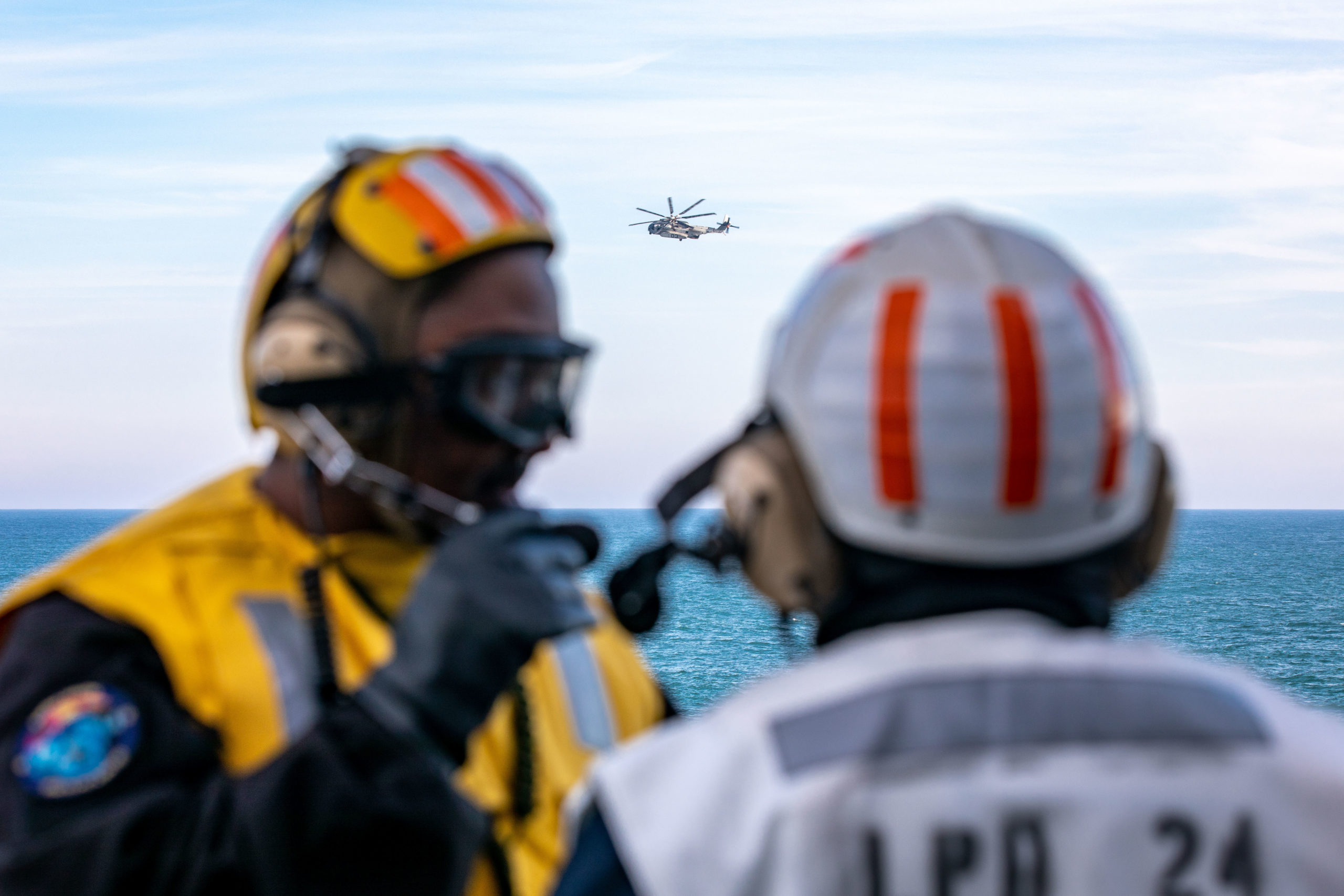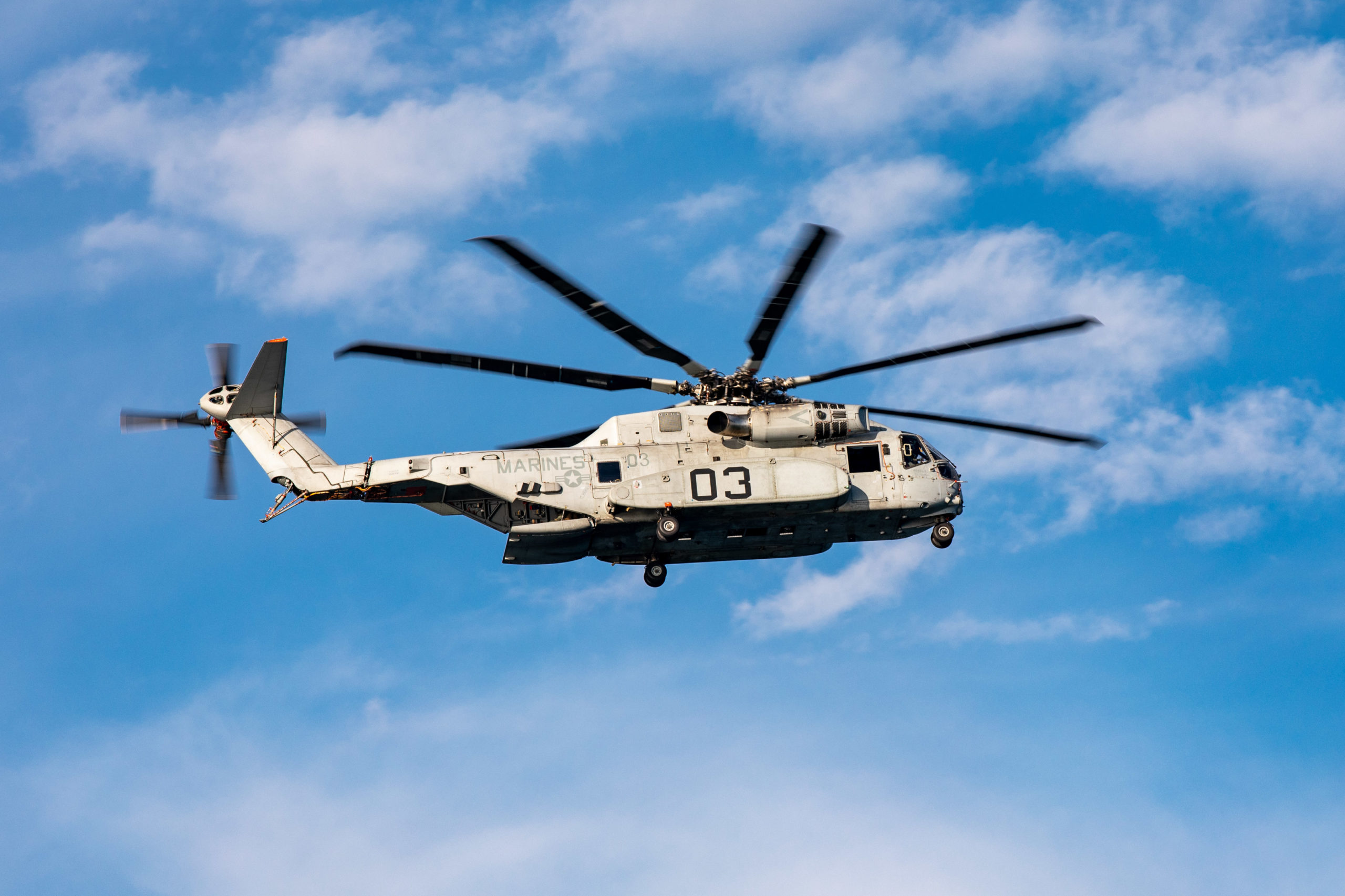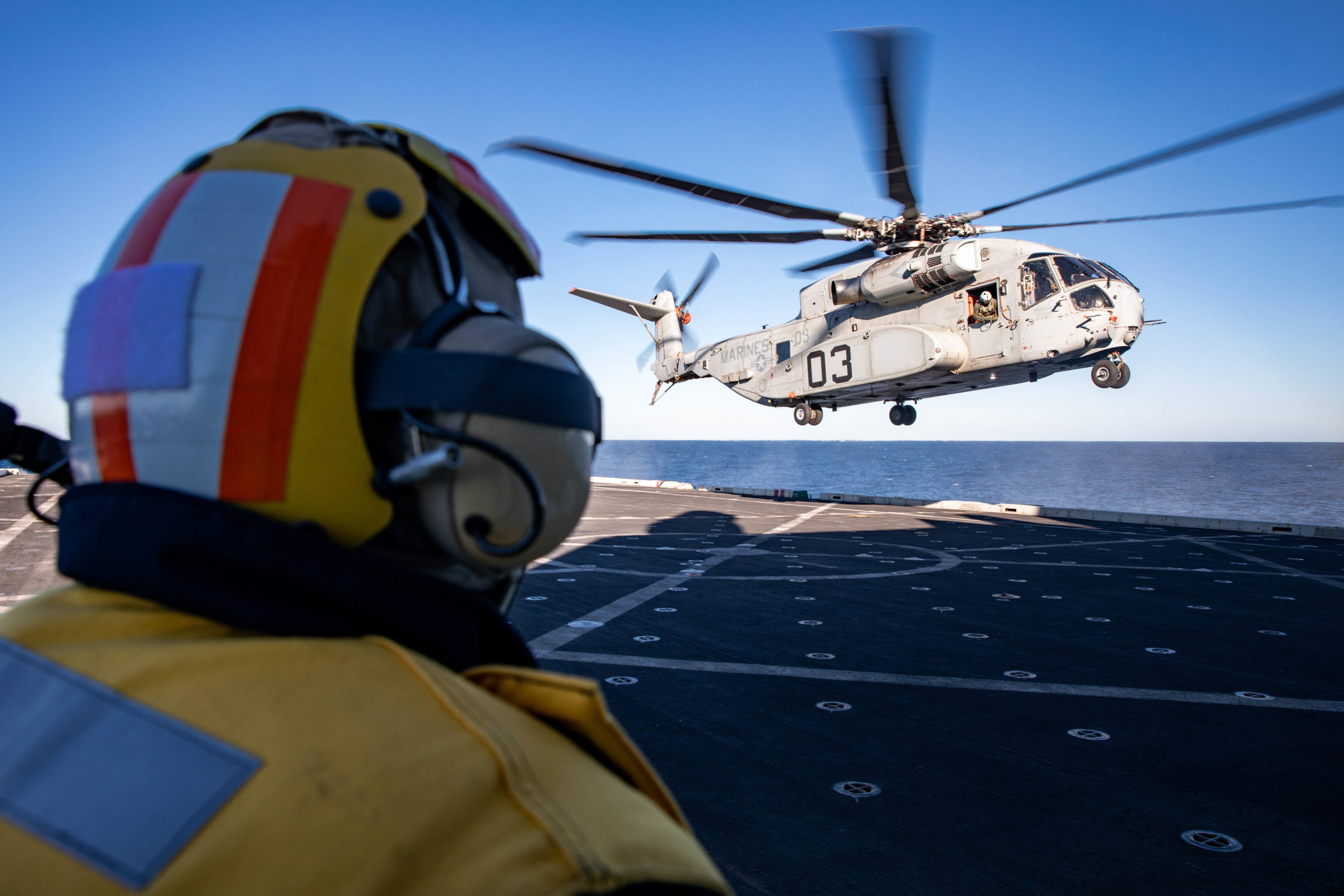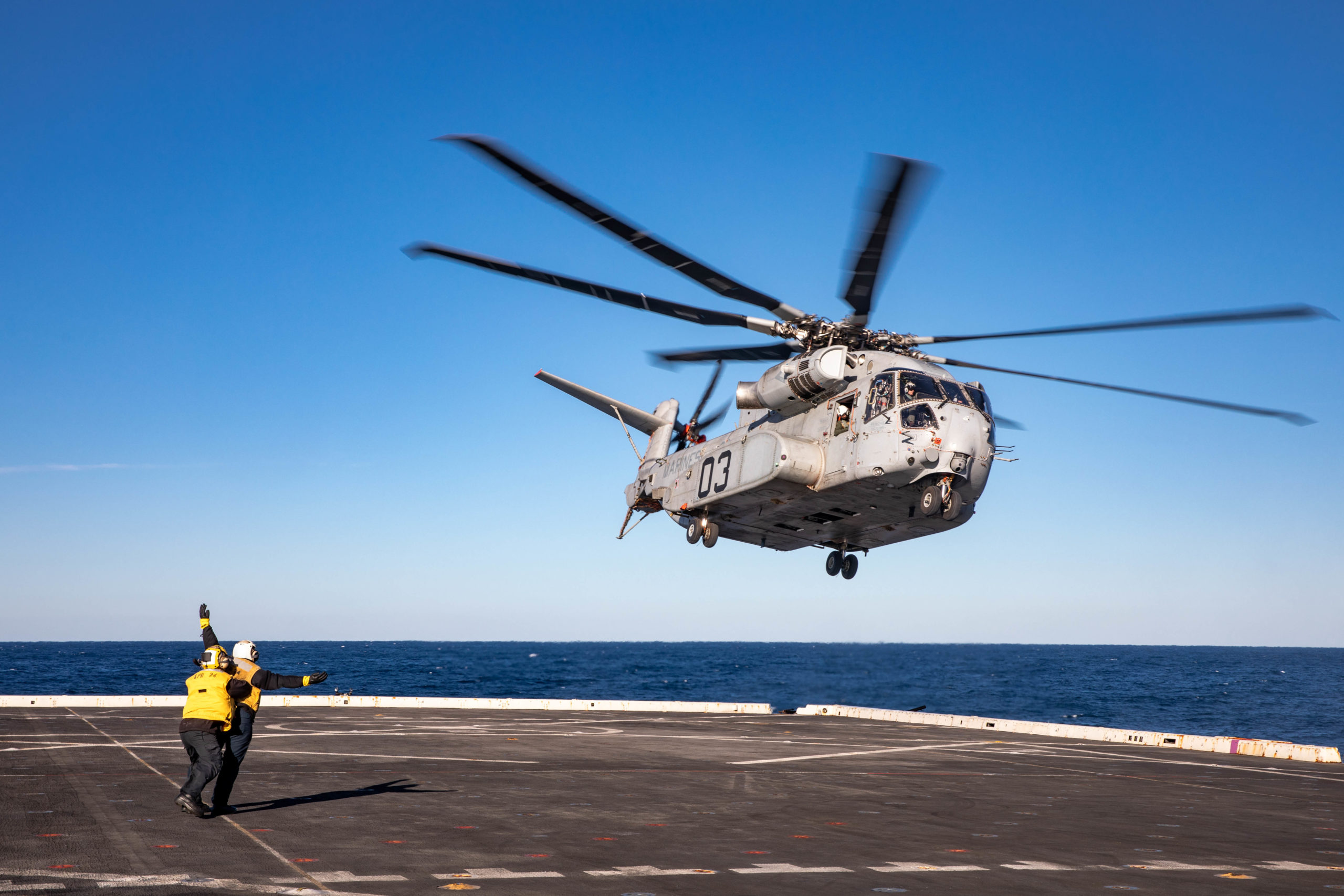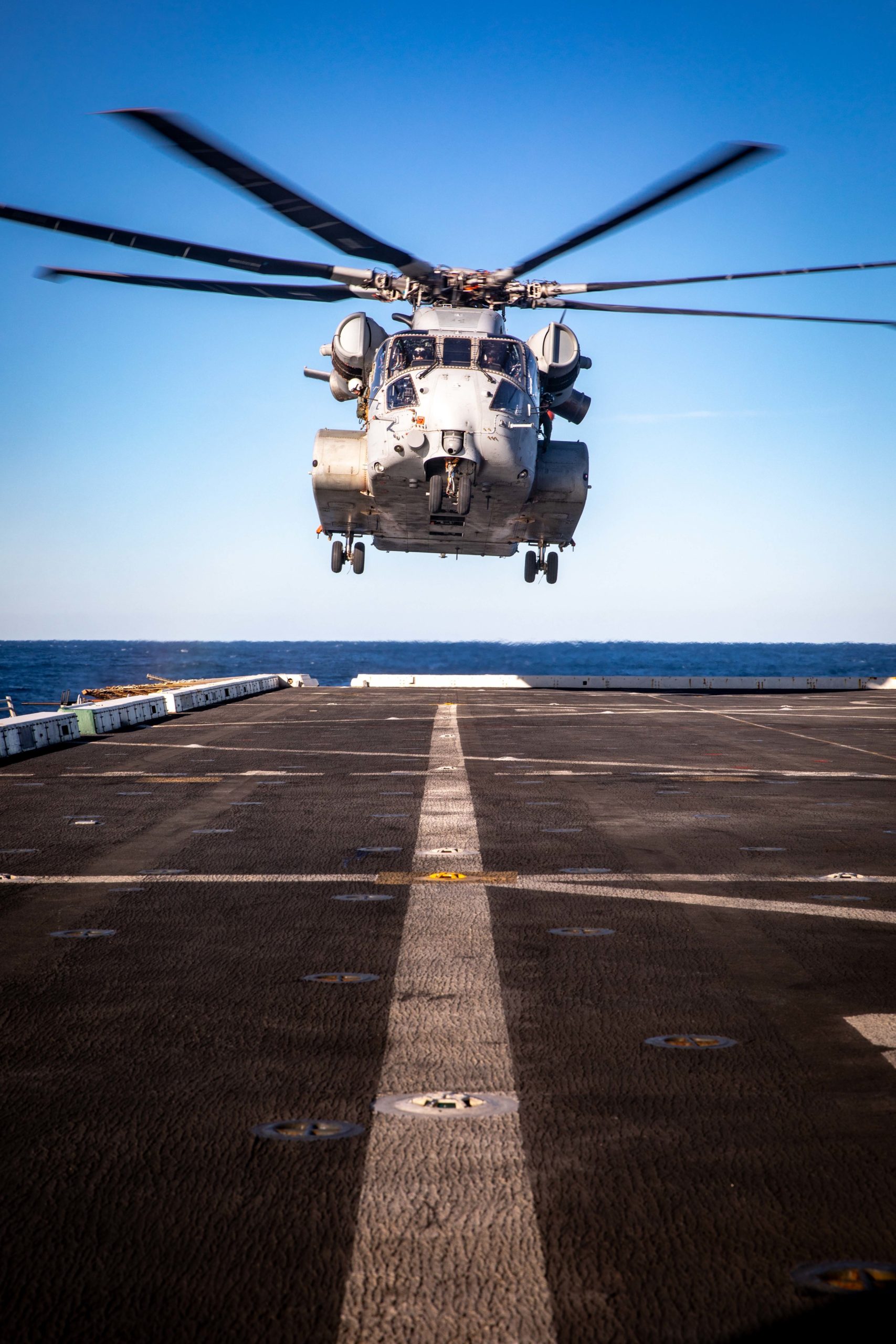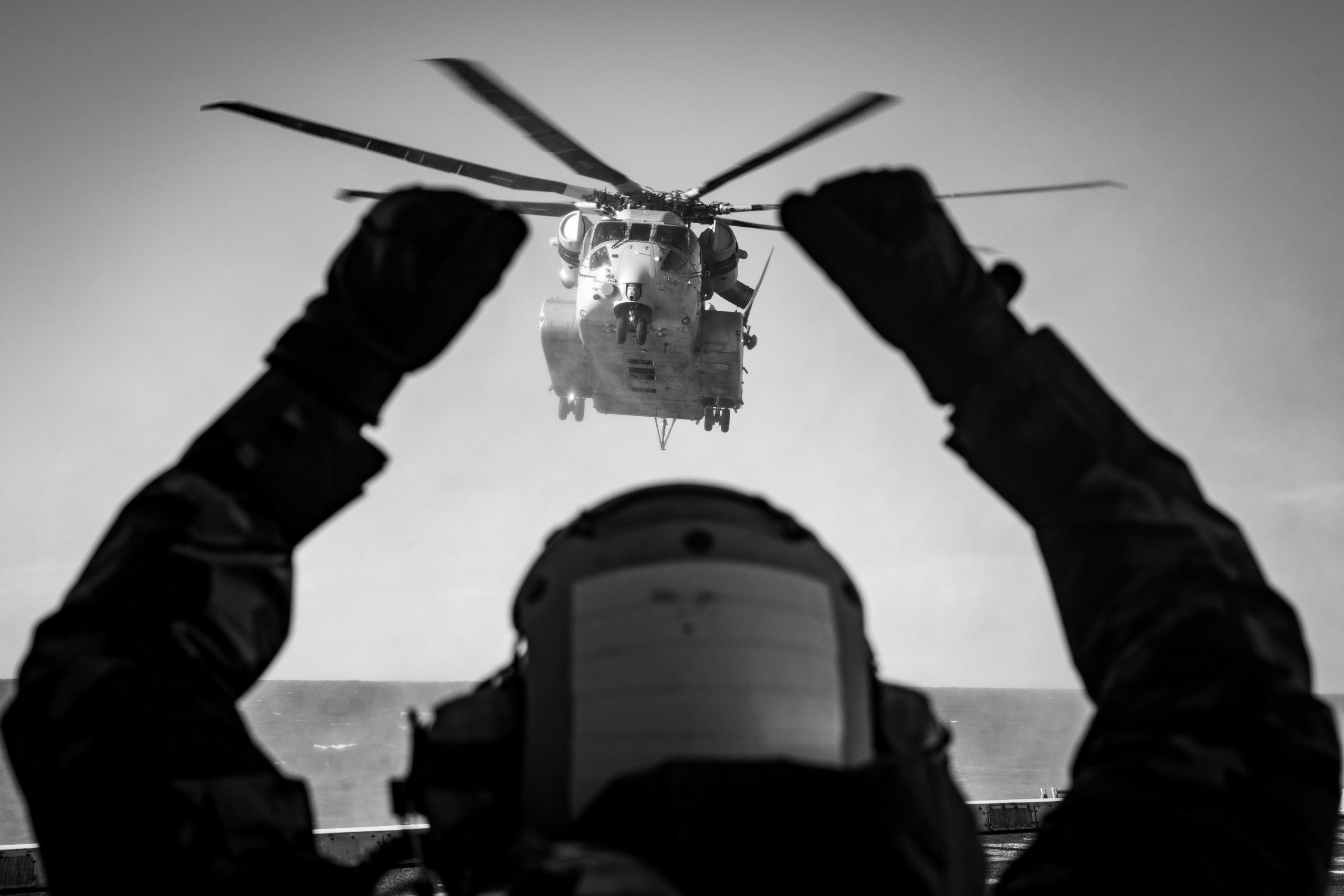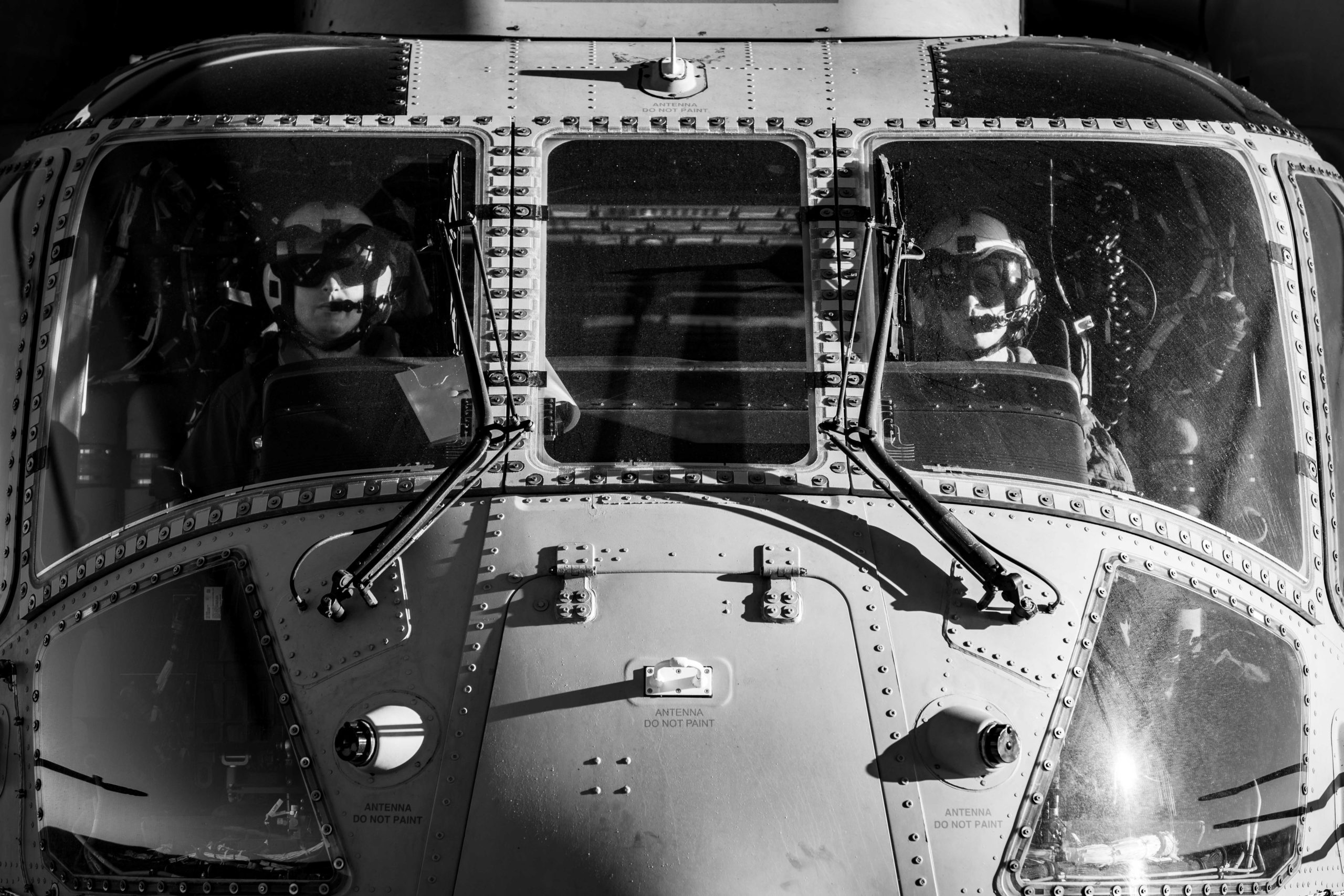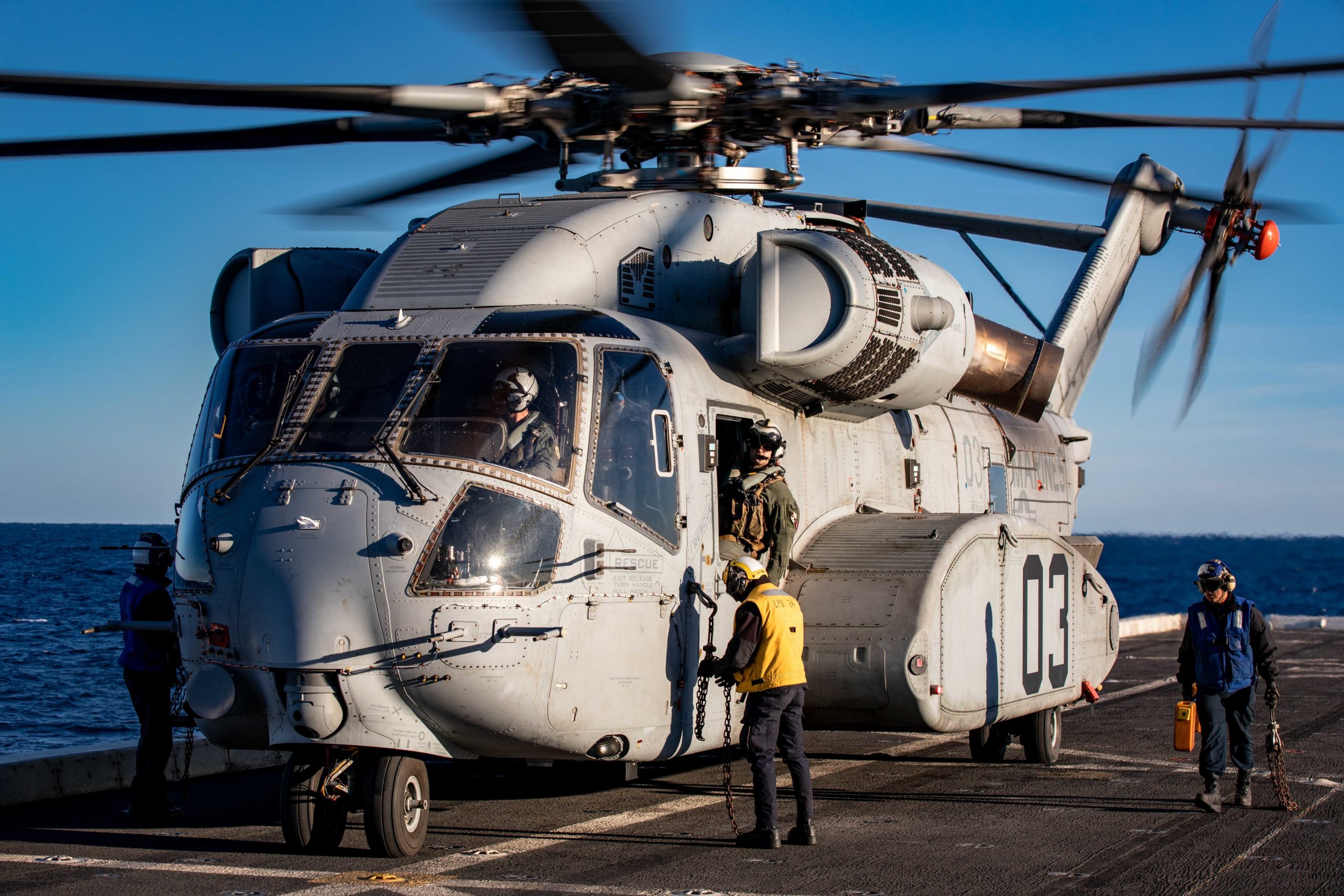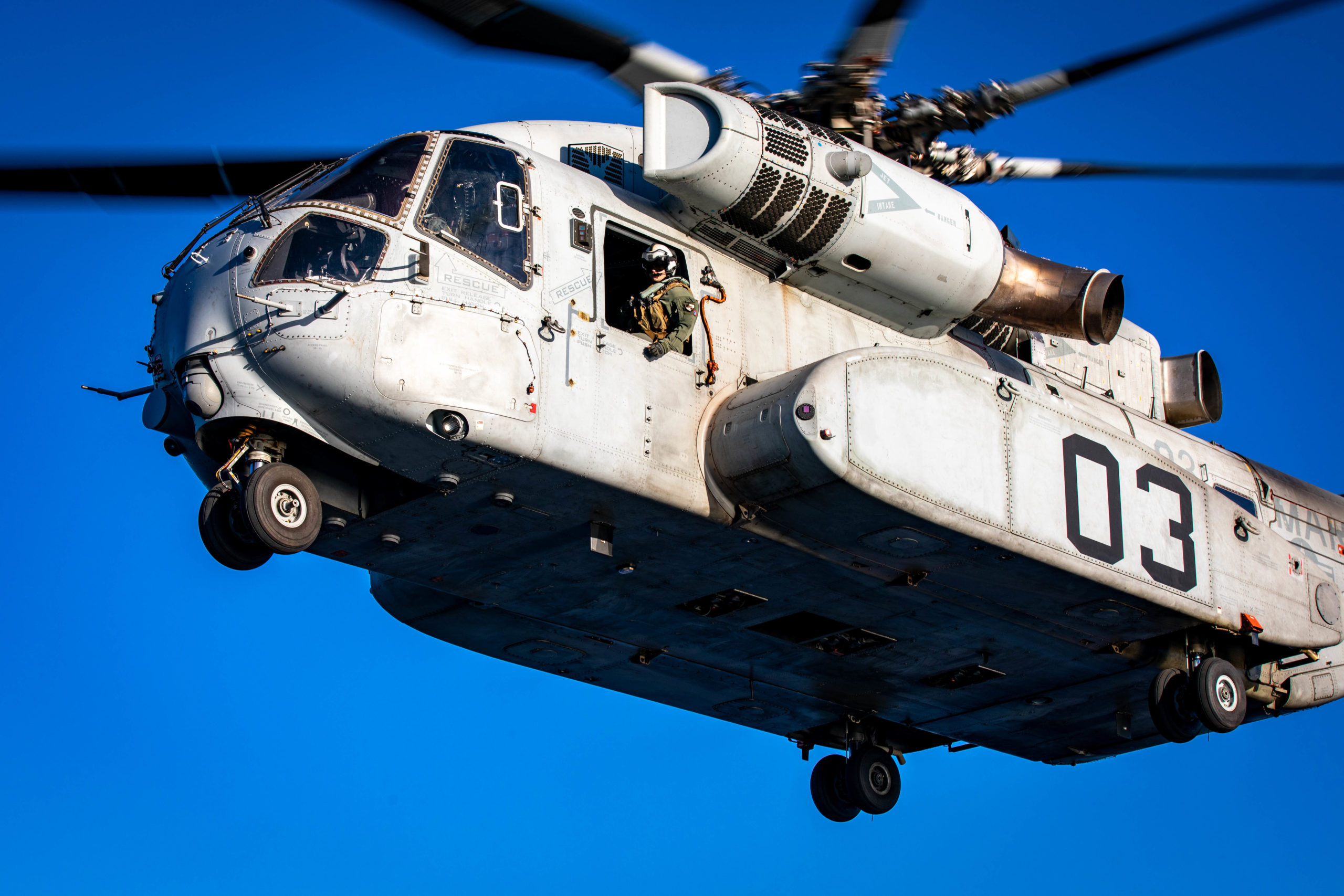By Robbin Laird
Recently I visited NAVAIR at Pax River Naval Air Station and met with the H-53 Heavy Lift Helicopters Program Manager (PMA-261), Colonel Kate Fleeger, U.S. Marine Corps. This officer has a very distinguished and interesting background, which intersects well with the coming of the CH-53K to the USMC, which is in the midst of its latest transformation, which highlights force mobility and distributed operations.
Her full biography can be read at the end of the article, but I asked her at the end of the interview that given her background of working with a variety of defense systems, what in her background did she see as being most relevant to the task of working on bringing the CH-53K to the fleet in a time where both the Marines and the Navy are prioritizing distributed operations to provide for both enhanced lethality and survivability.
Col. Fleeger: “What I’ve enjoyed most about my career is making the connections between seemingly disparate concepts and entities and bringing them together into a coherent capability. And what the 53K brings to the Marine Corps is the ability to connect the different nodes of a distributed force.”
I will return to the connectivity and transformation points after reviewing the state of the program as highlighted by Col. Fleeger. The Colonel provided a succinct and comprehensive overview of the program she has managed at NAVAIR since her arrival last year.
Col. Fleeger: “2022 was really a big year for the program! I’m sure you’re tracking that VMX-1 (Marine Operational Test & Evaluation Squadron 1) completed Initial Operational Test & Evaluation (IOT&E) and the Marine Corps declared Initial Operational Capability in April of last year. That paved the way for a Full Rate Production decision by Assistant Secretary of the Navy for Research, Development, & Acquisitions in December.
“The decision to move to Full Rate Production, from my perspective, was a vote of confidence both by the Marine Corps, of course, and the US Navy acquisition chain concerning the readiness of the 53K to transition as planned into the Marine Corps.
“The program of record is for 200 aircraft. We are currently in the 10s to low teens per year build rate. After that we will ramp up to the 20s per year capacity. We currently have nine aircraft already out in the fleet in two different squadrons. One squadron is the operational test squadron, VMX-1, at New River. The second is HMH-461 which is part of MAG-29 at New River, which is the first operational squadron. In addition to the seven aircraft already at HMH-461, we expect them to receive two more aircraft this spring and summer with a total of four to six aircraft by the end of the year.
“The plan is for HMH-461 to be fully transitioned to the CH-53K by the end of next year and be ready for a MEU deployment in 2025. We are focused on this effort.”
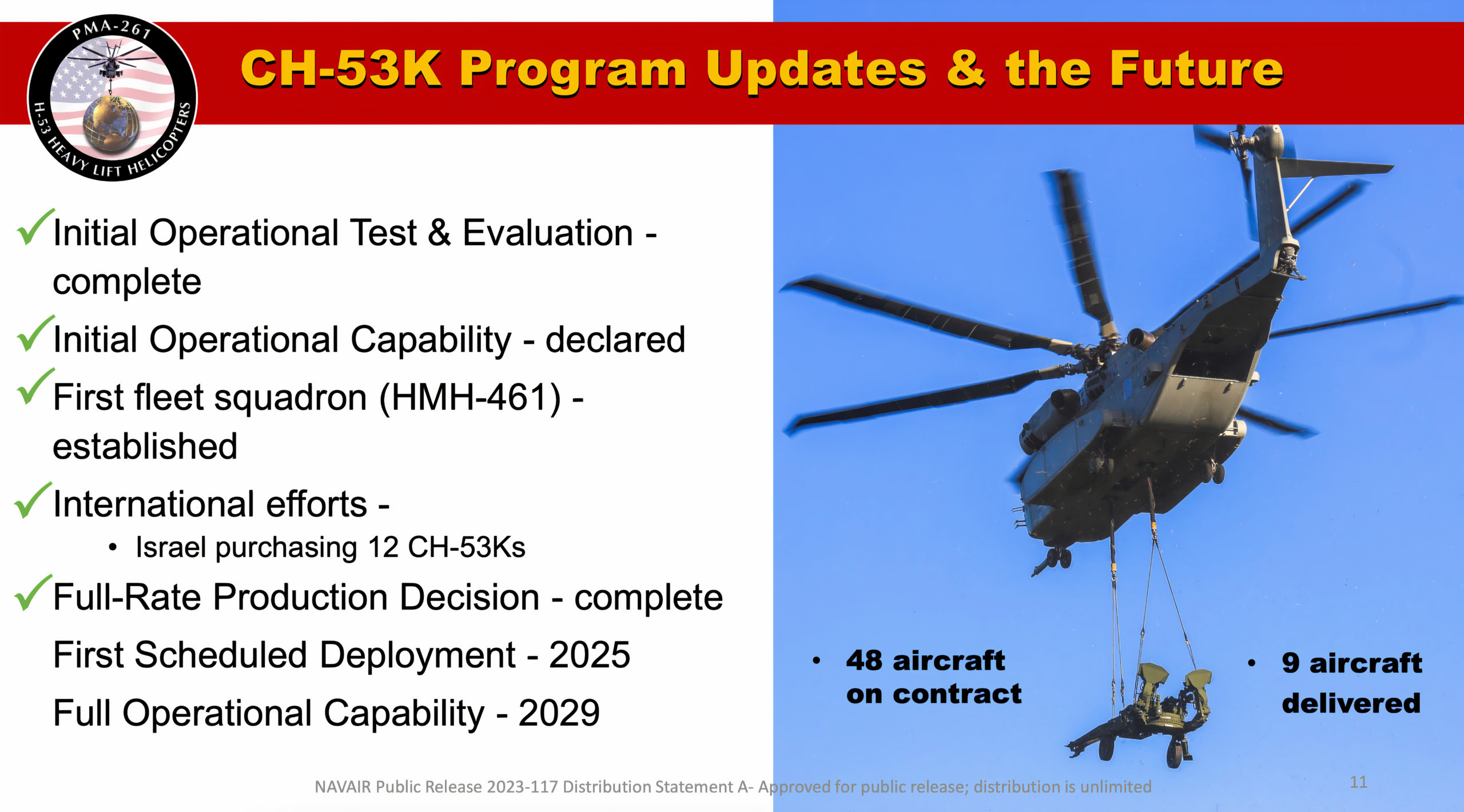
Slide from Presentation by Col Fleeger at the International Military Helicopter Conference, 2023
She also discussed the international aspect of the program. “The Israelis are the first international partner in the program. This provides not only cost savings overall for the production run but also provides an an opportunity to share innovative aircraft concepts of operations with the USMC The Israelis have ordered 12 aircraft to date with an option for another six.”
Col. Fleeger indicated that Lt. Col. (Ret) Lucas Frank, who has been my host during past visits to VMX-1 at New River, has retired from the USMC but is working program’s international team on aircraft training concepts and solutions for the Israelis.. Frank is a very knowledgeable expert on the aircraft, and certainly a key asset not just in working with the Israelis, but understanding the future possibilities of the aircraft.
We discussed how the naming of the helicopter as a CH-53 tends to obscure how different the CH-53K is from the CH-53E. I earlier wrote a piece entitled What if it was called the “CH-55? Transformation in the Vertical Heavy Lift Fleet” to underscore this point. She agreed: “I have argued we shouldn’t have used the numbers 53.”
This is true on two levels. The first level is that of performance and capability for the heavy lift mission as generally understood. The second level is the digital backbone of the CH-53K which makes the platform a key element in the distributed integratable force enabled by the kill web.
The first aspect was well laid out during a visit to VMX-1 in 2020 and a discussion with Lt. Col. Frank. He stated during that visit the following: “I’ve started in the Ch-53D in 2004, they’re my first love. I’ll always love them. They were much harder to fly. And the ease of flying this, the flight control system is probably the biggest game changer for the 53 community.
“We’re not used to anything like this. It’s very intuitive. It can be as hands off as you know, a brand-new Tesla, you can close your eyes, set the autopilot and fly across country. Obviously, you wouldn’t do that in a tactical environment, but it does reduce your workload, reduces your stress. And in precision hover areas, whether it’s night under low light conditions, under NVGs, in the confines of a tight landing zone, we have the ability to hit position hold in the 53 K and have the aircraft maintain pretty much within one foot of its intended hover point, one foot forward, lateral and AFT, and then one foot of vertical elevation change.
“It will maintain that hover until the end of the time if required. that’s very, very stress relieving for us when landing in degraded visual environments. Our goal at VMX-1 is to create tactics that employ that system effectively. Some communities struggle with how they use the automation, do they let the automation do everything? Do they let the pilots do everything? How to work the balance? We’re working on a hybrid where the pilots can most effectively leverage automation.
“If you know you’re coming into a brownout situation or degraded visual environment, you engage the automation at a point right before the dust envelops you. And then in the 53-K, you can continue flying with the automation engaged. You continue flying with the automation engaged, and you can override it, but as soon as you stop moving the controls, it will take your inputs, estimate what you wanted and keep the aircraft in its position.
“It’s a very intuitive flight control system, and it blends very well with the pilot and the computers. It allows you to override the computer. And then the second that you stop overriding it, the computer takes back over without any further pilot input. That’s probably the biggest game changer for our community.”

02.16.2022 Graphics by Cpl. Lauren Salmon, 2nd Marine Aircraft Wing
The second aspect was a key part of the discussion with Col. Fleeger. She emphasized the digital backbone built into the aircraft, and its ability to operate within a distributed force leveraging that force’s digital systems and its ability to contribute to that overall digital capability as well.
And when it comes to connectivity, the CH-53K is a key enabler for distributed logistics capability for the USMC and for the joint force. This is how she put it: “The CH-53K is a key element in the logistical backbone for the distributed force for the Marine Corps – especially with the increasing emphasis on the importance of operating from a diversity of unimproved landing zones, as opposed to using bases and runways.”
Part of her background has been working in USMC-operated UAVs. And in this effort, she has had the opportunity to work the payload side of the UAV equation. This is especially important in bringing the payload dynamic with what a platform like the CH-53K could handle. It is not just a muscle machine. It can deliver a variety of payloads to the battlespace beyond traditionally what heavy lift has done in the past.
Col. Fleeger closed by emphasizing that such innovation was why it is so necessary to get the CH-53K into the hands of Marines. As she underscored: “The most important ideas are going to come from the employment of the aircraft by the Marines in either operationally relevant or operational situations. The most critical thing that we can do to facilitate the innovation that you’re talking about is to deliver the aircraft to the Marine Corps in accordance with the transition plan and get it in the hands of the operators.”
Colonel Kate Fleeger, U.S. Marine Corps
Colonel Kate Fleeger, a native of Olney, Md., earned a Bachelor of Arts degree in geosciences from Princeton University. She received her commission in 1999 and was designated a Naval Aviator in 2001. In 2010, she received a Master of Science in business administration and management with a certificate in Project Management from Boston University. In 2011 she graduated from the Naval War College with a Master of Arts in national security and strategic studies. In 2020, she graduated from the Eisenhower School at National Defense University, earning a Master of Science in national resource strategy.
After designation as a CH-53E pilot, Fleeger completed three deployments in support of Operation Iraqi Freedom with Marine Heavy Helicopter Squadron (HMH) 465 before transferring to Marine Aviation Training System Site (MATSS) New River, N.C., in 2006. Here she gained initial acquisitions experience, serving as Contracting Officer’s Representative and subject matter expert for several contracts.
Fleeger transferred to Naval Air Station (NAS) Patuxent River, Md., in 2011, serving as the H-53 Assistant Program Manager for Training Systems for the Heavy Lift Helicopters Program Office, (PMA-261), and in 2013, she took over as the Strategic Operations Lead. In 2014, she became the H-53E In-Service Sustainment Lead and led the 15th Marine Expeditionary Unit Digital Interoperability effort for CH-53E and MV-22B. She became the CH-53K engineering class desk in 2015 and led the development and execution of an innovative plan to accelerate first flight.

In 2016, Fleeger transitioned to the Navy and Marine Corps Small Tactical Unmanned Aircraft Systems (UAS) Program Office (PMA-263) as the Advanced Development Integrated Product Team (IPT) lead responsible for development and fielding of Signals Intelligence, Synthetic Aperture Radar, and Wide Area Surveillance payloads. She subsequently transitioned to the Medium UAS IPT where she oversaw both RQ-21 and MQ-27 programs.
In 2018, she was selected as the VH-92A IPT lead in the Presidential Helicopter Program Office (PMA-274) and in 2020, she became the CH-53K IPT lead, in the Heavy Lift Helicopters Program Office, (PMA-261).
She served as the Chief of Staff for Program Executive Officer, Air Anti-Submarine Warfare, Assault, and Special Mission Programs from August 2021 – May 2022. In May 2022, Fleeger assumed command of PMA-261 as program manager.
See the following:
What if it was called the CH-55? Transformation in the Vertical Heavy Lift Fleet
https://defense.info/system-type/rotor-and-tiltrotor-systems/ch-53k/


